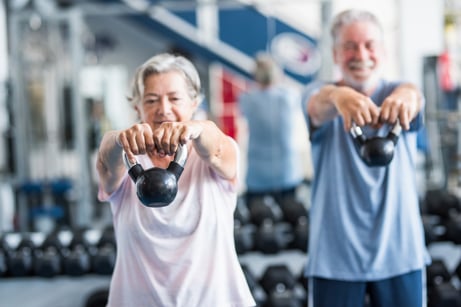 High intensity interval training (HIIT) sounds like something that is best for the 20-40 year old or athletes, however research begs to differ. Studies show that high intensity interval training is good for all ages, even if there are chronic health issues and you’re not a lifelong exerciser. In fact, HIIT workouts may be able to provide more benefits than other less-intense modes of exercises, such as steady state cardio.
High intensity interval training (HIIT) sounds like something that is best for the 20-40 year old or athletes, however research begs to differ. Studies show that high intensity interval training is good for all ages, even if there are chronic health issues and you’re not a lifelong exerciser. In fact, HIIT workouts may be able to provide more benefits than other less-intense modes of exercises, such as steady state cardio.
Steady state cardio vs Interval training vs HIIT
When most people go to the gym, they get on their favorite piece of cardio equipment set the speed and move at the same rate throughout their workout. This type of cardio is known as steady state cardio. Sometimes, people will use the different functions on the machines such as hills, weight loss or interval training. All of these have a different levels of high and low intensity. This is known as interval training. HIIT workouts are similar to interval training with the primary difference being the intensity of interval. With a HIIT workout the intensity is between 80-95% of your maximum heart rate. (220-your age= your maximum heart rate)
Benefits of HIIT Workouts
Increases Muscle Size and Strength
Did you know it is common to lose eight pounds of muscle as we age? Maintaining or improving muscle mass is not only important for everyday physical tasks like picking things up, reaching for something, getting up out of chair, but healthy muscles are essential for organ function, skin health, immunity and your metabolism.
Stronger Heart and Better Lung Capacity
Numerous studies have found that HIIT workouts are more beneficial than steady state cardio at improving cardiorespiratory. A study published in Cell Metabolism found that cycling between short periods of intense exercise and periods of recover, improved both cardiovascular and respiratory health in older adults. The over-65 group specifically experienced an impressive 69 percent increase in their ability to take in oxygen.
In addition, research shows that HIIT and interval workouts put less stress on the heart when compared to steady state aerobic exercise.
Lower blood sugar and insulin resistance: We know exercising is beneficial for losing weight, however according to a report by the Aarhus Hospital in Denmark, a short 10 minute HIIT routine three times a week, is one of the most effective forms of exercising for reducing type-2 diabetes risk and lowering blood glucose levels to healthy levels.
Improves Memory: Memory loss is something that can affect us all, however as we age our memory recall seems to fade. HIIT exercises are very beneficial for improving memory. Specifically, it improves the high-interference memory—the kind that helps you tell two similar things or memories apart.
Ready, Set, Go: Before starting any new exercise regimen, make sure to get clearance from your doctor. The best way to integrate HIIT workouts into your current exercise plan is to start with longer rest periods, such as 1 minute high intensity followed by a 3 minute recover. As your recovery improves, work on shortening the recovery time. Remember to have an effective HIIT workout, giving yourself time to recover is key.
Some ways to add HIITS to your current workout routine
Walking: Start by walking at a comfortable pace. Then for one minute walk as fast as you can and pump your arms and/or raise your knees. If you’re on a treadmill, increase the elevation. Then walk at a pace that will allow your breathing and heart rate to come down.
Swimming: Swim a few laps at your normal speed, then swim one lap at an all-out sprint. Go back and swim at your normal or a little slower speed.
Bike/Nu Step: Start by peddling with little or no resistance. To raise the intensity you can either increase your speed, increasing resistance or both. After your sprint, go back to the speed/resistance you started with.

